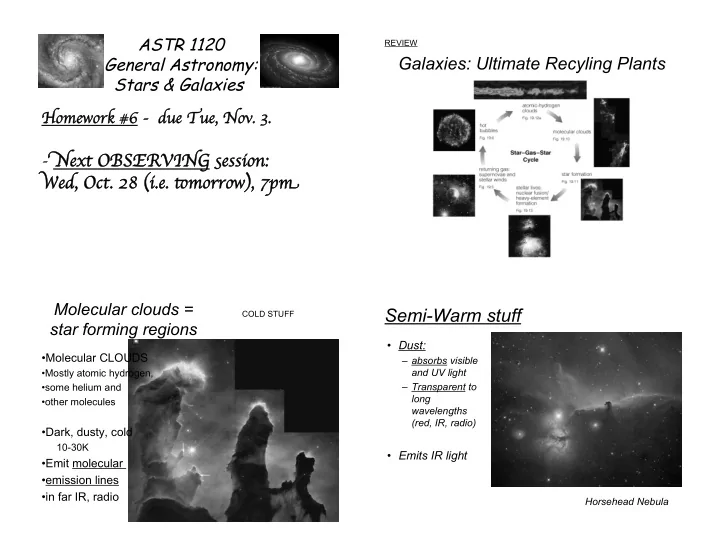

ASTR 1120 REVIEW General Astronomy: Galaxies: Ultimate Recyling Plants Stars & Galaxies � omework #6 - due Tue, Nov. 3. - � ex ext O OBSERVIN IN � � es ession ion: � ed ed, O , Oct. 2 . 28 � i.e. i.e. � morrow orrow � , 7 , 7p � Molecular clouds = Semi-Warm stuff COLD STUFF star forming regions • Dust: •Molecular CLOUDS – absorbs visible and UV light •Mostly atomic hydrogen, •some helium and – Transparent to long •other molecules wavelengths (red, IR, radio) •Dark, dusty, cold 10-30K • Emits IR light •Emit molecular •emission lines •in far IR, radio Horsehead Nebula
Really Hot Stuff Hot stuff Ionization nebulae Hot star “O & B star associations” winds from aging stars • Hot stars ionize hydrogen and other elements in the gas • T~ 10,000 K near hot young stars (10 ly across) Lagoon Nebula More hot stuff Some stuff is REALLY HOT Planetary Supernova & Nebula Remnants • Bubbles of hot gas blown out by SUPERNOVAE • T = tens of millions of degrees K • Mixing with rest of galactic gas � enrichment with heavy elements
Inside our Galaxy: Material is Superbubbles & Fountains Constantly Being Recycled • When multiple bubbles join (from a cluster) they can create superbubbles. • Superbubbles can blast hot gas even out of the Galaxy! • “Enriches” gas between galaxies • Some will rain back down and mix into the Galaxy Artists’ conceptions! Clicker Question Summary of Galactic Recycling Is the process of galactic recycling From HOT to COLD going to continue to infinity? • Stars make new elements by fusion • Dying stars expel gas and new elements, producing A. Yes Gas Cools hot bubbles (~10 6 K) • Hot gas cools, allowing atomic hydrogen clouds to B. NO form (~100-10,000 K) • Further cooling permits molecules to form, making molecular clouds (~30 K) BE PREPARED TO • Gravity forms new stars (and planets) in molecular clouds DEFEND YOUR ANSWER
Clicker Question Clicker Question Is the process of galactic recycling The ages of stars suggest that the bulge going to continue to infinity? and halo of the Milky Way formed before many of the stars in the disk. Which would A. Yes you expect to have more heavy metals B. NO (a.k.a. higher metallicity)? A. Halo and bulge stars BE PREPARED TO B. Disk stars DEFEND YOUR ANSWER C. No difference Clicker Question We observe star-gas-star cycle operating in Milky Way’s disk using many different wavelengths of light The ages of stars suggest that the bulge and halo of the Milky Way formed before many of the stars in the disk. Which would you expect to have more heavy metals (a.k.a. higher metallicity)? A. Halo and bulge stars B. Disk stars C. No difference
Infrared light reveals stars whose visible light is X-rays are observed from hot gas above and below the blocked by gas clouds Milky Way’s disk Infrared Visible X-rays We also see “point” sources – these are X-ray binaries 21 cm radio waves emitted by atomic hydrogen show Radio waves from carbon monoxide (CO) show where gas has cooled and settled into disk locations of molecular clouds Radio (21cm) Radio (CO)
Long-wavelength infrared emission shows where Gamma rays show where cosmic rays from supernovae young stars are heating dust grains collide with atomic nuclei in gas clouds IR (dust) � -Rays Outlining starbirth in M51 What Clues to Our Galaxy’s History Do Halo & Disk Stars Visible Infrared Hold? (Kitt Peak) (Spitzer)
Clicker Question Halo Stars: 0.02-0.2% heavy elements (O, Fe, …). Which stars formed first? A. Halo stars B. Disk stars C. All stars formed at the same time D. Not enough information given Disk Stars: 2% heavy elements Halo Stars: Clicker Question Halo stars 0.02-0.2% heavy elements (O, Fe, …), formed first, only old stars. (called Population II ) then stopped Which stars formed first? A. Halo stars B. Disk stars C. All stars formed at the same time D. Not enough information given Disk Stars: 2% heavy elements, stars of all ages, large fraction of young stars ( Population I )
Clicker Question Clicker Question What kind of star is most likely to be a What kind of star is most likely to be a part of the Halo population? part of the Halo population? A. An O star A. An O star B. An A star B. An A star C. An M star C. An M star D. All stars are equally likely D. All stars are equally likely E. There are no stars left in the spheroidal E. There are no stars left in the spheroidal population. Only supernova remnants. population. Only supernova remnants. Halo Stars: Halo stars 0.02-0.2% heavy elements (O, Fe, …), formed first, How Did Our Galaxy Form? only old stars. (called Population II ) then stopped Disk Stars: Disk stars 2% heavy elements, formed later, stars of all ages ( Population I ) kept forming
Our galaxy probably formed from a giant gas cloud Halo stars formed first as gravity caused cloud to contract Stars continuously form in disk as galaxy grows older - stars remain in disk plane Remaining gas settled into spinning disk
Warning: This model is oversimplified Detailed studies: Halo stars formed in clumps that later Careful study of heavy-element proportions suggests that our galaxy formed from a few different clouds. merged Galactic Creation Summary • What clues to our galaxy’s history do halo stars hold? – Halo stars are all old, with a smaller proportion of heavy elements than disk stars, indicating that the halo formed first • How did our galaxy form? – Our galaxy formed from a few huge clouds of gas, with the halo stars forming first and the disk stars forming later, after the gas settled into a spinning disk
Recommend
More recommend